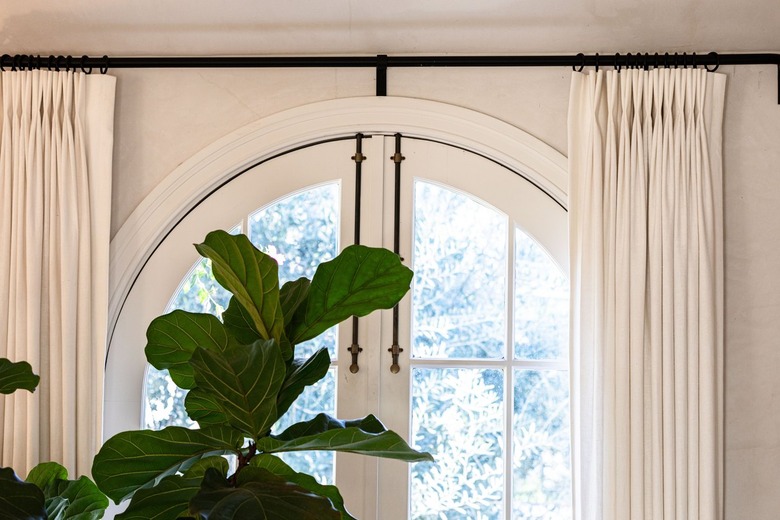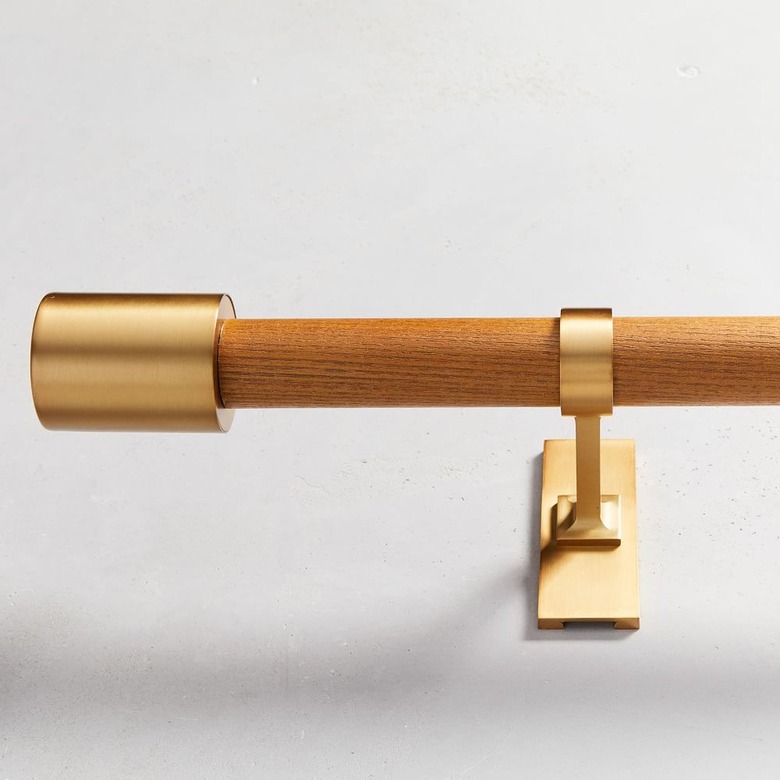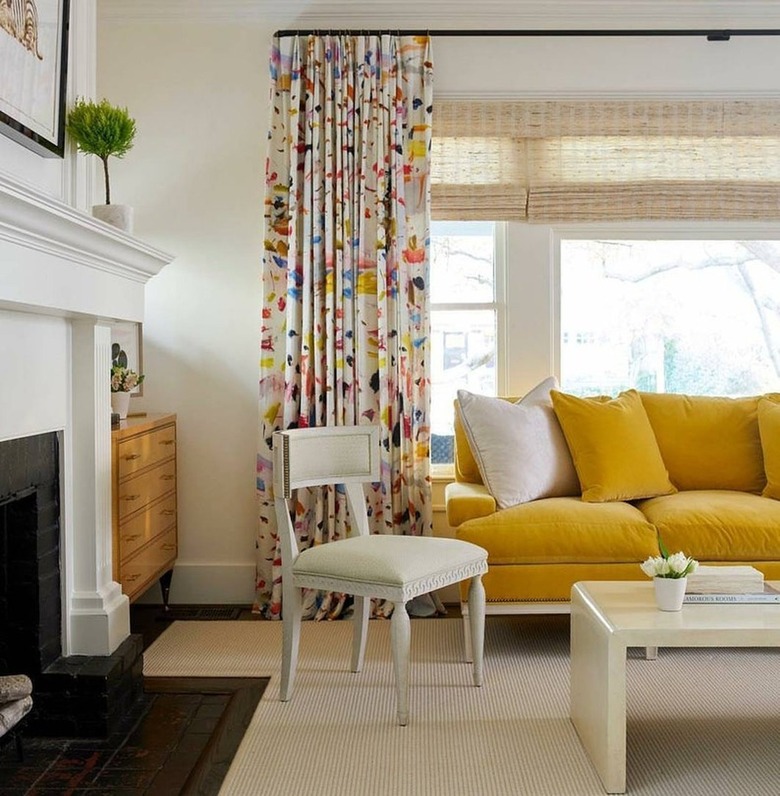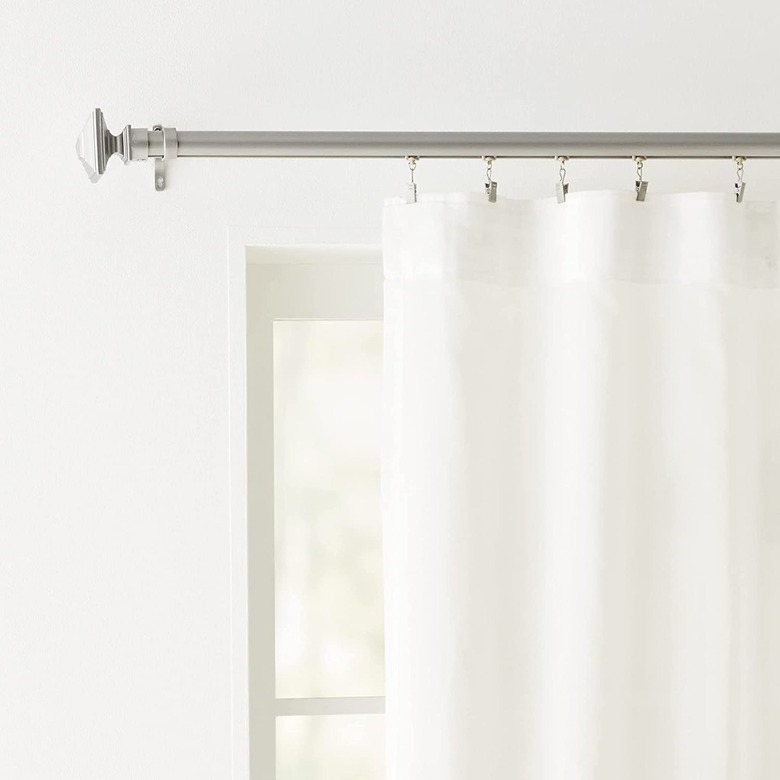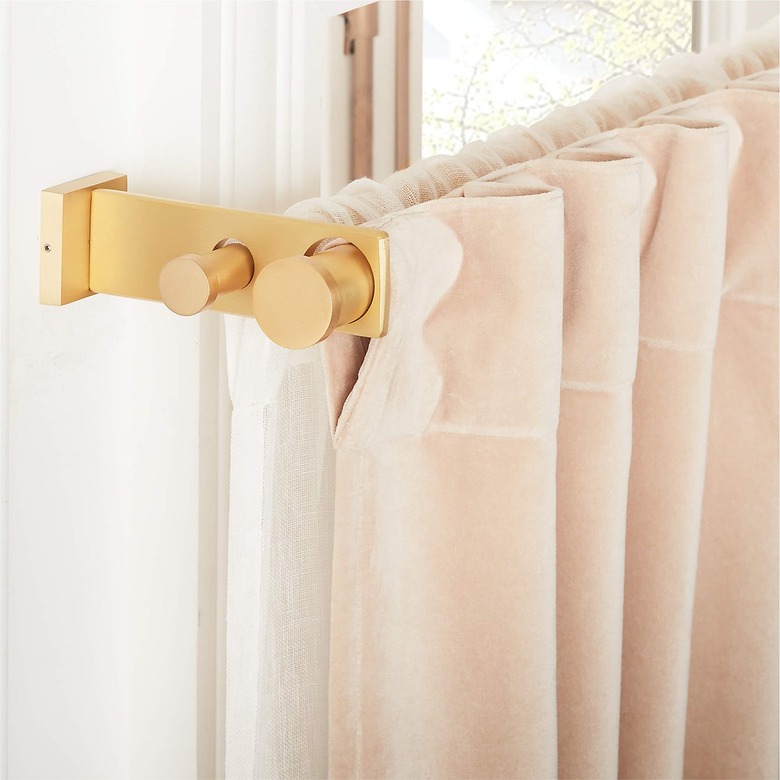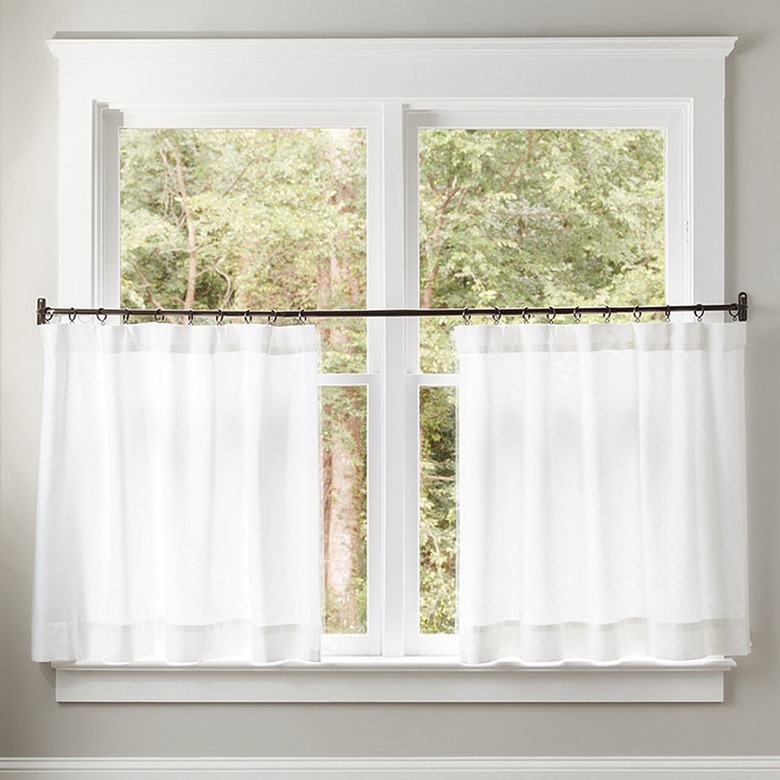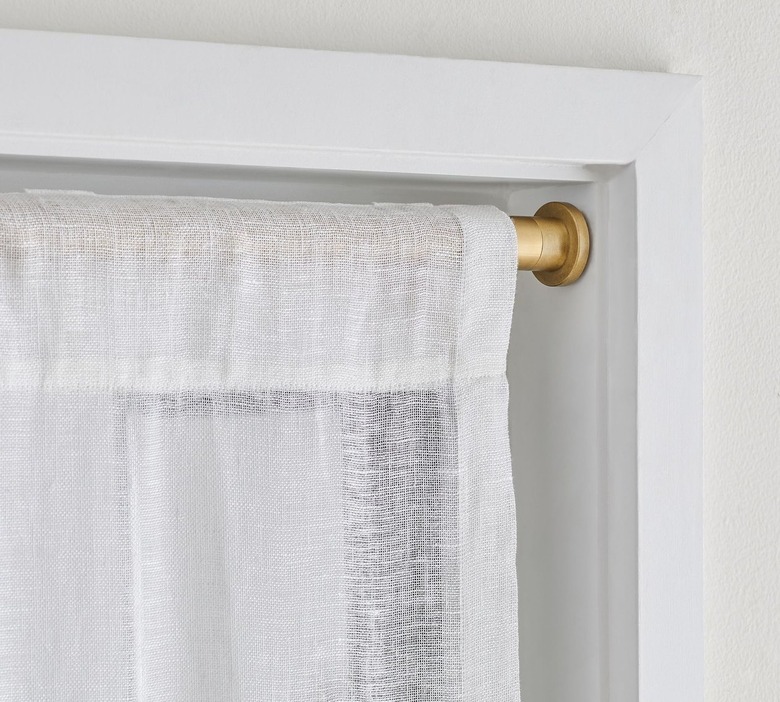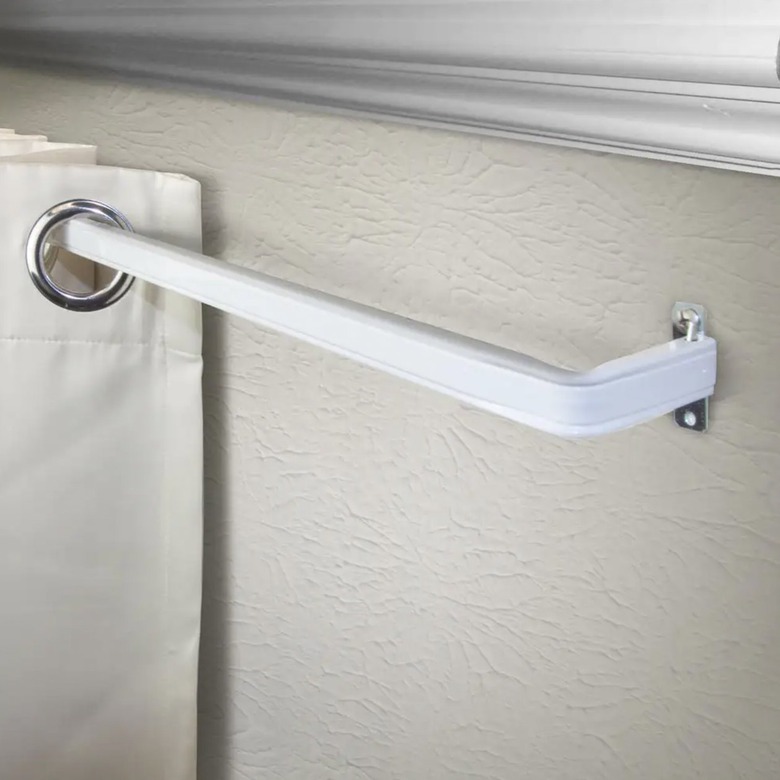The 8 Types Of Curtain Rods — And Where To Use Them
We may receive a commission on purchases made from links.
When looking at window treatments, it's fairly common to place all of your attention on the drapery, but you can't hang curtains without a curtain rod. In fact, your choice of curtain rod will play a dramatic role in the overall appearance of the window. Because some curtains and drapes are incompatible with certain types of curtain rods and curtain hardware, you should always buy your curtains before the rod and the rod before the curtain hardware. Before you go shopping for a curtain rod, take the time to familiarize yourself with the different types of rods and the associated hardware.
Understanding Curtain Hardware and Accessories
Understanding Curtain Hardware and Accessories
Before getting into the different kinds of curtain rods, it can pay to familiarize yourself with the hardware and accessories commonly used to hang curtains. Depending on your choice of curtain and rod, a few common pieces of hardware you may need include:
- Finials: These are
the ends of a curtain rod that prevent the curtain from sliding off. Not all
rods require these, as some rods have ends that mount directly to the wall, but your choice
of finial can add a lot of style to the overall appearance of the curtains.
While many curtain rods are sold with finials, they typically come in a
universal size so you can change them as necessary if you find that the perfect
finials are sold separately from your chosen rod. - End caps: Similar
to finials, these are much more simple fittings that attach to the ends of curtain rods. They
are most commonly used on tension rods, where they help stop the rod from
slipping once secured inside the window frame. - Curtain rings: While some curtains have a built-in rod pocket or grommets that
allow them to slide right on the rod, those that are flat or pleated
require separate hardware. In most cases, this means using curtain rings,
though traverse rods have built-in clips, bypassing the need for extra
hardware. - Brackets and sconces: Although some curtain rods support
themselves,
such as tension rods, most do not. That means you will usually need either a bracket or a sconce to support the rod and the drapes. Brackets are the simpler of
these options since they are typically just metal or wood hooks or loops attached
to the wall or ceiling. For something really dramatic, though, a wooden or metal
sconce can add a lot of flair to your decor. - Pulls: Most
curtains are installed without pulls, but these can make opening and closing
your curtains much easier. It's worth noting that when they are made from solid materials,
pulls can also be called wands. - Curtain holdbacks or tiebacks: As the name implies, these are products
designed to hold back curtain panels to let in natural light. Curtain holdbacks
are hard materials, such as metal hooks, that hold the curtain outside the
window frame. These are occasionally sold as part of a curtain rod set or with other hardware to
create a cohesive design. Tiebacks are typically made from fabric that is
wrapped around the curtain and either secured to a hook on the wall or tied
together in a bow or knot. Tiebacks are occasionally sold with drapery so they
can contrast or complement the color or pattern of the curtains.
Types of Curtain Rods
1. Single Curtain Rod
As you might guess by the name, this is simply a single curtain rod made from wood or metal. These are sold in a wide variety of lengths, shapes, and diameters, and metal poles are often adjustable to allow users to get the perfect fit. Single curtain rods are sometimes sold in kits with matching finials, curtain rings, and brackets.
Single curtain rods are highly versatile and can be used in every room. They can be found in designs that will complement just about every decor scheme imaginable.
Our pick: Rejuvenation Trask Adjustable Drapery Rod Set, starting at $170
2. Decorative Curtain Rod
One notable type of curtain rod is the decorative rod, which is specifically designed to be seen in order to add an extra wow factor to the room. Decorative rods come in a wide array of materials, colors, widths, and lengths, and they are typically paired with decorative finials and often set in decorative sconces to further attract attention to their beauty. Common materials include wood, brass, brushed nickel, oiled bronze, wrought iron, and pewter. These specialty rods are often expensive, and many are even custom-made.
Because decorative curtain rods are meant to be seen, they are best used in rooms guests frequent, such as the family room, living room, and dining room.
Get the look: West Elm Midcentury Curtain Rod, starting at $90
3. Wrapped Curtain Rod
Also known as French rods, these curtain rods curve at the end where they are fastened to the wall, which helps block light at the ends. On smaller windows, French rods do not typically need any brackets, but for larger windows, they may require a support bracket in the middle of the rod.
Since wrapped rods are so effective at blocking out light, particularly when paired with blackout curtains, they are a popular option for bedrooms.
Get the look: Eclipse Wrap Around Curtain Rod, starting at $24.99
4. Traverse Curtain Rod
Technically not a rod at all, a traverse curtain rod is a metal track fitted with drapery hooks. These tracks may be fitted on a ceiling or hung from the wall, and because they are screwed into studs at regular intervals, they are particularly sturdy, which makes them a great option for heavy draperies and allows them to span great distances, making them a fantastic option for larger windows.
They can be opened with a pull cord or a rod that drags the curtains along the track, and some particularly high-end models can be operated remotely. They can even be connected to your smart home system, which is very useful for notably wide windows. It's worth mentioning that traverse rods are sold in two-way (also called a split-draw) and single-direction models, meaning they may open from the middle, sending the curtains out two ways from that point, or they may travel in only one direction along the track.
While most people think of traverse rods as looking like a basic metal track, they come in a wide array of styles, some of which look like traditional metal or wooden curtain rods. Because traverse rods have built-in drapery hooks, they cannot be used with grommet or rod-pocket curtains and should instead be paired with flat designs or those with pleats.
Since their design allows them to hold a lot of weight and span great distances, traverse rods are best used on large windows or sliding glass doors in the living room, kitchen, or dining room, but they can also be good for any room where you want to install heavy, formal drapes.
Get the look: Canora Grey Felecia Decorative Traverse Curtain Single Rod, $134.99
5. Double Curtain Rod
Many types of curtain rods can also be purchased in a double model. This includes decorative, traverse, wrapped, and more. Double curtain rods allow users to layer different types of drapery over one another. There are even triple bracket curtain rods that can hold up three types of drapery at once.
Double and triple drapery rods are typically used to add a layer of elegance or romance to a room, but they can also be used to improve the versatility of the window treatments. As an example, many people use a double curtain rod to place decorative valances along the top of their curtains, but they could also be used to install sheer curtains under heavier blackout drapes, adding an increased level of privacy even when the room-darkening curtains are opened to let in a little sun.
Get the look: Etta Avenue Totham Adjustable Double Curtain Rod, $82.99
6. Café Curtain Rod
Café curtains are shorter curtains that only cover the bottom half of a window, making the window appear smaller and the entire room feel cozier. For this reason, the curtain rods designed specifically for these types of window treatments are designed to look casual and somewhat nondescript. Café curtain rods are small in diameter and are typically round or fluted with small, subtle finials. While they can be found in a wide number of materials and finishes, they are frequently sold with brass finishes.
Because they are supposed to look casual, café curtain rods look particularly good when paired with rod-pocket, tab-top, or tie curtains. Their small diameter also means they should only be used with light curtains. Because the bottom half of the window is covered and given privacy while light can still shine in over the top, these curtain rods are a popular option in bathrooms. They are also common in rooms in which people typically like to feel cozy, such as kitchens, dining nooks, and laundry rooms.
Get the look: Ballard Designs Classic Café Panel, $129
7. Tension Curtain Rod
For those who are renting or otherwise don't want to drill into their walls or window frames, tension rods are a great option since they support themselves with pressure, meaning they use no hardware at all. That's because they use a simple screw and spring system to create tension that holds them in place in a window frame. The simplicity of the tension rod is its main selling point, as it can be used to fit in almost all window openings and can be removed and reinstalled as needed without causing any damage to the walls, though it may sometimes remove a small amount of paint, especially if the rod was pulled on while it was in place.
Tension rods often get a bad name because people tend to associate them with cheap shower curtains and college dorms, but there are many attractive designs available these days that don't look like the typical white pole with flared white end caps that many people envision when they talk about tension rods. That being said, they do still have their drawbacks, most notably that you can only use lighter curtains on them because too much weight causes them to fall. Tension rods must also be used on windows with large enough window frames to support them. They are most commonly used in areas like living rooms, family rooms, laundry rooms, kitchens, kids' rooms, and garages.
Get the look: Pottery Barn Tension Curtain Rod, starting at $59
8. Concealed Curtain Rod
As the name implies, a concealed curtain rod is a rod designed to never be seen underneath the curtains. The most common style of these is the white metal lock-seam rod, which is a wrap-style rod that features two thin, flat, interlocking metal pieces. The wide pocket rod is essentially the same thing, only it's designed with a wider arm and is most commonly used for shirred valances. Some tension rods with thin end caps can also be used as a concealed curtain rod, as can many sash rods, like those used to hold curtains on French doors. No matter the style, concealed curtain rods can only be used with window treatments that feature a rod pocket in order to cover the rod entirely.
Because these curtain rods are meant to not be seen, they are typically best used in rooms where you usually leave the curtains closed. As an alternative, you can purchase a double concealed curtain rod and use a valance on the outer rod to hide the underlying rod when the curtain is open.
Get the look: Wayfair Basics Adjustable Single Curtain Rod, $10.99
Choosing the Right Curtain Rods
Choosing the Right Curtain Rods
Your curtain should help guide you when deciding on the right rod for your room. The first thing to consider is how much the curtain weighs. Heavy drapes require sturdy curtain rods, like a wood or metal straight rod or a traverse rod. To ensure your rod will be strong enough, divide the weight of the curtains by their length to find out the weight per foot ratio and verify that the curtain rod is designed to hold that much weight. Keep in mind that with the exception of traverse rods, longer curtain rods over 72 inches will need a support bracket in the middle, which means the curtains will not be able to move back and forth across that point.
Also, consider the hanging method of the curtains. Draperies that require curtain rings are usually best used with a straight, traverse, or wrapped rod. For curtains that have rod pockets, grommets, or tie tops, ensure the rod diameter is not too large. It's also important to buy brackets wide enough for your rod, which is why you should buy hardware after buying the rod.
Measure the window frame to find the proper curtain rod length. Unless the space is very snug or you are using a tension rod, add 10 inches to the total measurement so the curtains can open as wide as possible, maximizing how much of your window is exposed.
